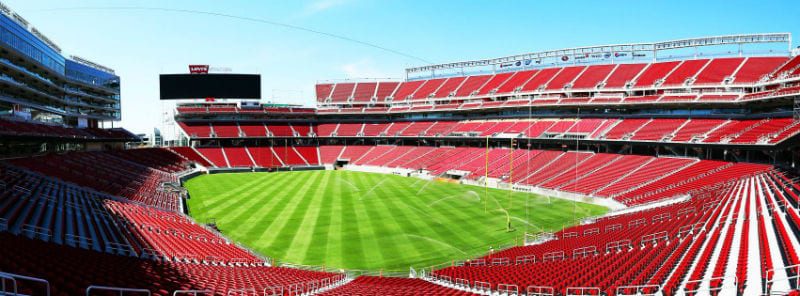How Will the Super Bowl Handle Record Amounts of Wi-Fi Traffic?

Super Bowl 50 is fast approaching and as one of the most attended events in the world, it will be a wireless madhouse. Everyone is going to be in the stands sharing pictures, videos and tweets. Not to mention the employees will be staying connected along with the teams and coaching staff. What we don’t want is another incident where one team loses signal during the game, which happened to the Patriots a few weeks ago with their Microsoft Surface Tablets.
Levi’s Stadium in Santa Clara California can hold nearly 70,000 fans. Add that to the teams, their staff and stadium staff and you have a decent sized city. It’s actually a bit more complicated than that; while giving an entire 70,000 resident city would present problems due to the actual distance between the device and the access points pales in comparison to having 70,000 people trying to get decent Wi-Fi speeds all within a square mile of each other, this is the thing IT department nightmares are made of.
To this day, people are skeptical of the “free Wi-Fi” signs in public places. Most of the time it’s okay in a place like a coffee shop where there aren’t as many people and even fewer of them are trying to access the Wi-Fi. But in places where there are more people who are most likely to be accessing the Wi-Fi, like at a hotel, things can get a little hairy. People abandon the connection and would rather use their wireless data than deal with the snail-like speeds. This is what wireless vendors hate and are trying hard to fix.
To get a better understanding of what exactly goes into a stadium wireless infrastructure, Zeus Kerravala of Network World interviewed Chuck Lukaszewski, VP of Wireless Strategy for Aruba Networks. Lukaszewski also helped design and build the wireless network being used in Levi’s Stadium. Not only is this stadium said to be the most state-of-the-art mobile stadium in the country, but it’s also in the heart of Silicon Valley which leaves the expectations of this wireless network very high.
Lukaszewski tells Kerravala that that the main focus of the design is take rate and concurrent load:
“Take rate is a measurement of the percentage of seated people who will be accessing the network. Concurrent load is the number of users accessing the network at the same time. For stadiums, the average for these metrics is 50% and 25%, respectively.”
It’s important to over estimate those numbers to ensure that the speed is reliable for everyone and considering the even, Lukaszewski assumes that the take rate and the concurrent load will be twice the average for a stadium venue.
Levi’s Stadium will be equip with with 1,300 of Aruba’s latest 802.11ac access points that will be distributed amoung 1,200 beacons essentially rounding out to 1 AP for every 100 seats. But because this is a stadium, these APs need to be placed under the seats instead of overhead like in a traditional office setting.
Another statistic that was a major factor in the design is looking back at similar events and seeing how much total web traffic was generated from inside the stadium. Super Bowl 47 produced 1.1 TB of traffic in 2013. Super Bowl 49 generated a whopping 6TB of data while a Taylor Swift concert in Levi’s Stadium produced a staggering 7.1 TB of data last year. It’s safe to assume that Super Bowl 50 could produce over 10 TB of data.
We’ll see how these predictions go this coming Sunday during Super Bowl 50. Who are you rooting for?





![[VIDEO] The Top 15 VPN (Virtual Private Network) Providers](https://solutionsreview.com/wireless-network/files/2020/09/oie_FSoMPtJs9A1E-550x325.jpg)

















